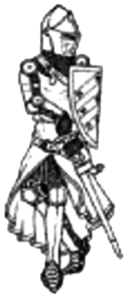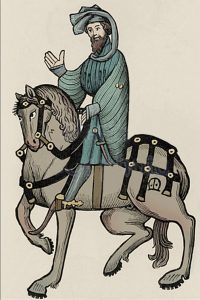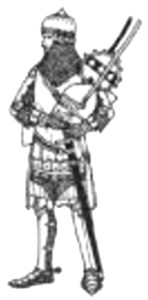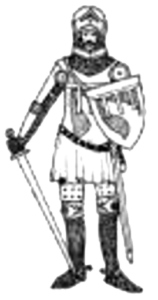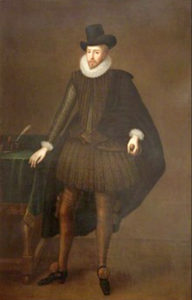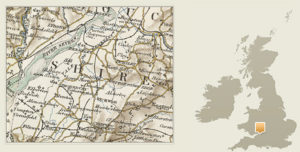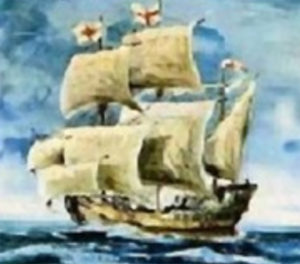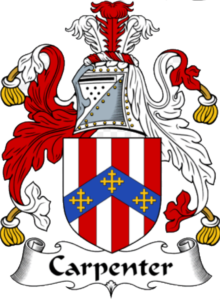

This story follows our Cherokee relatives from the mid 1600s though the Trail of Tears in 1839, and on into Oklahoma where they were relocated. Our family had five generations on the Trail simultaneously. Most of our family still resides in Oklahoma and are members of the Cherokee Nation. This account is told by Norma Sue (Baker) Macy whose 3rd great grandmother died in Kentucky while on the on the Trail of Tears. Some of the families covered here are: Hicks, Moytoy, Carpenter, Miller, Harris, Kearns, Patten, Baker, Macy, Clover and Clinton.
Our family history has more tributaries than the Mississippi River, as do all families. From these many branches, we have chosen to feature a lineage that is very special to us, since our grandmothers were of Cherokee heritage. This is a history of English noblemen, from the middle ages to the time of immigration to the ‘New World’ and the Cherokee people, coming together to blend into what is now our family.
Sixteen generations descended from Lord Robert Hicks, born in 1192, before Nathan Hicks was born in Albermarle Parish, Sussex, Virginia. He married Nancy Elizabeth (Broom) Ward, Hicks also called Nan Ye Hi Wolf and Nanye-Hi Ghi Ghau (the last Beloved Woman of the Cherokee). Nancy and Nathan Hicks were my 5th great grand parents. Nancy Elizabeth Ward (Wolf Clan) was descended from the line of influential Cherokee Chiefs, the Moytoy/Carpenters. Two of her grandmothers held the title of “Beloved Woman,” the highest honor bestowed on women by the tribe. Some of Nancy’s ancestry can be traced back to England and France as well.
The Hicks line is traced back to 1192 in England, but we begin this history in 1720 with Robert Hicks, whose father immigrated to Plymouth Colony. There were thirteen generations preceding Robert and Mary Hicks and those are detailed at the end of this narrative.
Robert Hicks (“Who went to live with the Indians”) was born 1720 in Albermarle, Sussex, Virginia. He died in Sussex, Sussex County, Virginia, on January 22, 1780. He was the husband of Mary (Courtney) Hicks b. 1710, d. 1752. Robert and Mary Hicks were the parents of Nathaniel Hicks. He had one brother and eight sisters. They were: Steven Hicks, Martha Sarah (Hicks) Bass, Amy Hicks, Elinor (Hicks), Nallapy and (second marriage) Rice, Susanna Hicks, Ann Hicks, Jean Hicks, Jane Hicks, and Tabitha Hicks Robert was the son of John Hicks and Rebecca (Rives) Hicks.

Nathan and Nancy
Nathaniel Hicks
The son of Robert Hicks and Mary (Courtney) Hicks. He was born in November 6, 1743 in Albermarle Parrish, Sussex, Virginia. He died in 1829 at Spring Place, Georgia, Cherokee Nation East.
His first marriage was to Nancy Elizabeth Ward (Broom) ‘NanYe-Hi Wolf who was born July 20th, 1736 in Chota, Cherokee nation East. She died at Benton, Polk County, Tennessee in 1822. Nancy and Nathan were married in (1757-1758) in Cherokee Nation East, Overhill, Georgia. (Washington, Tennessee). The children of Nathan Hicks and NanYe-hi made a significant impact on the history of the Cherokee Nation. Two sons, Charles Renatus Hicks and William Abraham Hicks served as Principal Chiefs of the Cherokee Nation, and daughter Elizabeth (Hicks) Fields, was for a time, the wife of the Texas Cherokee Principal Chief Richard Fields.
This is Emmet Starr’s account concerning the early Hicks family. This excerpt is taken from The History of the Cherokee Indians, page 260:
“Broom’s town was the home of Chief Broom who’s daughter Nancy, a member of the Wolf clan, married Nathan Hicks, a white man. Nathan and Nancy Hicks where the parents of Charles, William and Elizabeth Hicks, who married James Vann, Richard Fields, Eliphas Holt and William Campbell. There were possibly other brother brothers and sisters, but their names are unknown. Charles Hicks was probably born in the decade between 1760 and 1770. It is not known when he was educated as there were no schools among the Cherokees during his boyhood. He joined the church of the United Brethren at Spring Place and was baptized on April 10, 1813 at which time the missionaries, as was their wont, conferred upon him the middle name of Renatus or the renewed; Charles Renatus Hicks.”
Nancy Elizabeth Ward Hicks born Broom was also known as Nanye-Hi-Ghi-Ghau Ward and Nannie Ward. Her mother and father were Tame Doe White Owl Raven Kitigusta and Anakwanki Skayagustuegwo “Chief Broom”. She had three marriages, two of which were very early in her life. She was married to “Tsu-la”, Kingfisher of the Deer Clan in about 1751. She was about fifteen years of age at that time. He died in battle in 1755. She then wed an already married white trader named Bryant Ward who soon returned to his white wife in South Carolina. Nancy was about 22 years old when she wed Nathaniel Hicks. The marriage lasted about 15 years and they had six children.
This is an account of an important event in her life, for which she is renowned. It occurred when she was married to her first husband, Tsu-la also known as “Kingfisher”. As a young mother of two during the Battle of Talliwa against the Creeks, she crouched behind a log, loading the guns for her husband, Kingfisher. She chewed the ends of the bullets to make them cause more damage. When he was killed, NanYe’Hi picked up his gun and continued the battle, rallying the Cherokee to victory.
The Cherokee made her “The Ghi-ga-u” a Beloved Woman, a position reserved for brave and wise women who served as their people’s guide.
 As a child, Nancy Ward was known as “Tsituna-Gus-Ke” (Wild Rose) “from the delicate texture of her skin which was likened to rose petals.” Her mother, Tame Doe, was a member of the Wolf clan and the sister of Chief Attakullakulla. It is said that Nancy may have learned both the Cherokee and English languages from her mother.
As a child, Nancy Ward was known as “Tsituna-Gus-Ke” (Wild Rose) “from the delicate texture of her skin which was likened to rose petals.” Her mother, Tame Doe, was a member of the Wolf clan and the sister of Chief Attakullakulla. It is said that Nancy may have learned both the Cherokee and English languages from her mother.
NanYe-Hi, Nancy Elizabeth, was born into a powerful family of the Wolf Clan about 1736 at Chota City of Refuge, Cherokee Nation East. Her father was Skayagustuegwo Fivekiller, a Cherokee-Delaware man also called Chief Broom. He is thought to be related to the famous Delaware leader and peacemaker, Chief Taminand, (b.1625, d.1701) through his birthfather, Fivekiller Taminand.
Early in her life, Nancy is said to have had a vision of spirits helping her find her way home after she had become lost. Thereafter she became known as “NanYe-Hi” which means “One who is with the Spirit People”.
Nancy Elizabeth became a leader within the Cherokee nation and because she held the title of Ghi-gha U, Beloved Woman of the Cherokee, Nancy was allowed to sit in councils and to make decisions, along with the Chiefs and other Beloved Women. She believed in peaceful coexistence with the European Americans and helped her people as a peace negotiator and ambassador. Nancy headed the Women’s council in the Cherokee tribe, which consisted of a representative from each clan, and she sat as a voting member of the council of Chiefs.
It was believed that the Supreme Beings often spoke to the people through the Beloved Women and they were given absolute power in the question of the fate of prisoners taken in war, a power given only to the Ghi Gha U. Nancy did not hesitate to use this power to save one such prisoner of war, Mrs. Lydia Bean, who had been sentenced to burn at the stake. She took Mrs. Bean into her own home and nursed her back to health after the ordeal. Mrs. Bean taught Nancy new weaving skills and cheese making methods, as well as to farm and raise live stock. Nancy introduced this new ways to her Cherokee People.
Nancy encouraged better relationships between the English and the Native Americans, and she was an advocate for women’s rights, both in the Indian Tribes and in the colonies. Because of her experience with war, she may have been influenced to become a peacemaker in her later life.
In 1772 an English diplomat, James Robertson, visited Nancy in her home at Chota (when she was about 35 years old). He described it as being furnished in a “barbaric splendor,” that befitted her high rank. He pictured her as queenly and commanding.
Nancy participated in the Treaty of July 20, 1781, and the Treaty at Hopewell, November 28, 1785, as a principal speaker. She emphasized her never-ending desire to seek peace for her people, and how important it was for the Cherokees to hold on to as much of their land as possible.
Nancy Elizabeth (Broom) Ward, Hicks was later in life known by the term of endearment “Granny Ward”. She was a caretaker of children and adopted two children, Meli Ward, (1774 -1825, born at Chota) and William S. Taylor, (1775-1837). Meli was the daughter of an unknown Cherokee warrior and a Cherokee mother and was half sister to Nancy’s children: Little Fellow Hiskitihi and Ka-ti Harlan (Tsu-La was father) and Elizabeth Betsy Hughes (Bryant Ward was father).
William S. Taylor was the biological son of John Taylor and unknown half Cherokeee mother. William married his adoptive sister, Meli, and they had about three children including General William S. Taylor.
After 1819, Nancy left Chota and settled on the Ocoee River close to Benton, Tennessee. She operated an inn at Woman Killer Ford until her death in 1822. Near the end of her life, Nancy reportedly had a vision in which she saw “a great line of our people marching on foot. Mothers with babies in their arms, fathers with small children on their backs. Grandmothers and grandfathers with large bundles on their backs. They were marching West and the ‘Unaka’ (white soldiers) were behind them. They left a trail of corpses, the weak, and the sick, who could not survive the journey.”
Nancy is buried on a hill nearby near Benton, Tennessee. In 1923, a monument was placed on her grave by a Chattanooga Chapter of the Daughters of the American Revolution.
The children of Nathan and Nancy were:
Sarah Gosaduisga, born 1758
Elizabeth Hicks, born 1759, died 1792
Mary Hicks, born 1763, died 1835
Nathan Wolf Hicks, born 1764, died 1801
Charles Hicks, born January 23, 1767 and died January 20th, 1827, Spring Place, Murray County, Georgia
William Abraham Hicks, born 1769, died 1828
Nancy Elizabeth (Broom) Ward, Hicks and Nathaniel Hicks
parted ways before the time of the Revolutionary War.
Nathaniel married a second wife later in life, Temperance (Dumas) Hicks.
They had about two children.
Elijah Hicks, born c.1797
Elizabeth Betsy Hicks, born 1771

Moytoy/Carpenter Family
Tame Doe White Owl Raven Kitigusta was Nancy Elizabeth (Broom) Hicks’ mother. Tame Doe was a member of the Cherokee Wolf Clan and was born around (1708-1710) in Telico and died in 1760 in Chota. She was buried at Coyatee, Cherokee Nation East, Tennessee. She was also known as Catherine Tame Doe Attakullakulla, Nancy Elizabeth, Betsy Owl (Little Carpenter), Tame Doe Raven, Nancy Nanye-hi Moytoy and Nancy Carpenter Moytoy.
Tame Doe married Anakwanki Skayagustuegwo ‘Fivekiller’ Kitigusto (also known as Chief Broom) in about 1729. He was Nancy Elizabeth (Broom) Hicks’ father. Tame Doe’s husband, Anakwanki Skayagustuegwo Five Killer “Chief Broom” of the Delaware tribe, was born (1710) in Cherokee Nation East, Broomtown, Tennessee and died circa 1792 in Rockdale, Georgia. He was also known as the Raven of Chota.
Anakwanki Skayagustuegwo Five Killer’s parents were Oshaqua Moytoy, (born Delaware) b.1674, d.1754, and Swan-Wapehti Hop Moytoy (born Shawnee-Powhatan), b.1664, d.1757. When Oshaqua’s parents were killed by Creek Indians he was adopted by Amadoniyi (Moytoy II) and Go-sa-du-isga (Nancy Carpenter). Skayagustuegwo’s father is also referred to as Taminad Five Killer of the Delaware (Turtle Clan, Lenni Lenape). He is also known as Oshaqua Moytoy.
Anakwanki Skayagustuegwo Five Killer’s mother, Swan Wapehti Hop, was adopted by Moytoy II as well, (Young Trader Tom Carpenter and Nancy). Swan’s parents were killed by Catawba raiders. Swan Wapehti Hop’s birth parents were Misahpelewa “Big Turkey” Hop, Sachem Cornstalk b.1660 and Nonoma, Powhatan a Chalakatha-Hopia woman, Shawnee.
Gosaduisga Nancy Quatsie Five Killer of the Shawnee b.1664, in Running Water Tennessee, is the other name for Swan Wapehti Hop, (Skayagustuegwo [Chief Broom] Five Killer’s mother). Anakwanki Skayagustuegwo Five Killer had two sisters, Ounaconoa Muskrat Moytoy and Ahneewakee Muskrat Moytoy.
It is the custom of the Cherokee people for the grandmothers to name the grandchildren. Swan-Wapehti Hop, also known as Gosaduisga, may have named her granddaughter, (Nathan Hicks and Nancy Elizabeth [Broom] Ward, Hicks’ first child), Sarah Gosaduisga Hicks.
Tame Doe Raven had 20 siblings, one of which was Chief Attakullakulla (‘Little Carpenter’ Cherokee Wolf Clan). An interesting comment was made by Attakullakulla during the 1757 treaty negotiations in the time of the French and Indian War. The Cherokee leader, who was Nancy Elizabeth Ward’s maternal uncle, expressed his surprise that no white women were present at the treaty negotiations. “Since the white man as well as the red is born of woman,” he said, “why does not the white man admit women to their councils?”
The Cherokee had a matrilineal society. This meant children belonged to the mother’s clan, and hereditary leadership and property were passed through the maternal line. Traditionally, women were considered the head of household among the Cherokee, with the home and children belonging to her if she should separate from a husband. Maternal uncles were considered very important in the lives of their nieces and nephews. Cherokee society was also matrilocal, meaning once married, a couple moved in with or near the brides family.
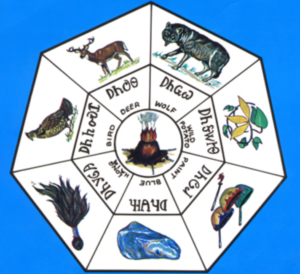 The Aniwaya, or the Wolf Clan was the largest and most important clan among the Cherokee people. Nancy Elizabeth (Broom) Ward Hicks’ grandmother, Nancy Moytoy of the Wolf Clan, or Morning Star lived circa 1683(85) to around 1777. She was also known as Nanye-Hi Moytoy, Ani’-Ga’tage’wi Kituah, and Go See Du Issue Raven. She was a member of the Cherokee/Shawnee Moytoy-Carpenter family and the daughter of the Cherokee chief Moytoy I of Chota and Quqtsie (Nancy Elizabeth) of Telico.
The Aniwaya, or the Wolf Clan was the largest and most important clan among the Cherokee people. Nancy Elizabeth (Broom) Ward Hicks’ grandmother, Nancy Moytoy of the Wolf Clan, or Morning Star lived circa 1683(85) to around 1777. She was also known as Nanye-Hi Moytoy, Ani’-Ga’tage’wi Kituah, and Go See Du Issue Raven. She was a member of the Cherokee/Shawnee Moytoy-Carpenter family and the daughter of the Cherokee chief Moytoy I of Chota and Quqtsie (Nancy Elizabeth) of Telico.
Morning Star was the wife of Motoy III (Savannah Tom Carpenter). They were married about 1706. Savannah Tom Carpenter was also known as White Owl Raven of Chota. He was born about 1680, at Chota, City of Refuge, Cherokee Nation East, Tennessee. He died April 31, 1741 at Oconee County, South Carolina.
He was the adopted son of Thomas “Young Trader Tom” Carpenter II and Ani’-Ga’tage’wi “Nancy” Carpenter, Cornstalk. It is said that Moytoy III (Savannah Tom Carpenter) was an Algonquin infant when captured. His birth father was Chief Taminad of the Delaware. He was adopted by the Cherokee tribe and was raised by Woman Nancy, and was of another clan. He was later adopted by Young Trader Tom and Nancy Gosaduisga Carpenter. That allowed him to marry Nancy Moytoy (Ani’-Ga’tage’wi Kituah) of the Wolf Clan, as people of the same clan are forbidden to marry by Cherokee law.
The children of Moytoy III (Tom Carpenter) and Ani’-Ga’tage’wi “Nancy” Carpenter, were: Attakullakulla; Tame Doe, Wolf Clan; Eliza Qua-tee Oo-loo-cha, Wolf Clan; Oosta White Owl Great Eagle; Susan Moytoy Priber; Willenawah/Tiffoya Moytoy; Corn Tassel Utsi’dsata Carpenter; and Clo-go-itah Carpenter.
Amadoniyi, (Moytoy II) was the great grandfather of Nancy Elizabeth (Broom) Ward Hicks. He was also called Pigeon of Telico, Emperor of Telico, Trader Tom Carpenter and Chief of Overhill. He was born around 1687 and died around 1760. He was the leading Chief of the Cherokees from 1730 to 1760.
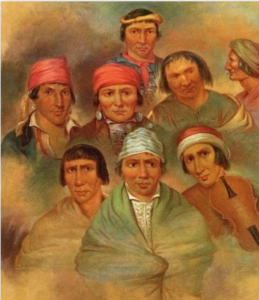 In 1730, Alexander Cuming, an unofficial envoy, of King George II, “appointed” Moytoy, the chief of Great Tellico, “Emperor” of the Cherokees. Moytoy, in return, recognized the English king’s sovereignty over the Cherokees. This was basically a trade agreement. Cuming arranged to take Moytoy II and a group of Cherokee to England to meet King George II. Moytoy declined to go, saying that his wife was ill.
In 1730, Alexander Cuming, an unofficial envoy, of King George II, “appointed” Moytoy, the chief of Great Tellico, “Emperor” of the Cherokees. Moytoy, in return, recognized the English king’s sovereignty over the Cherokees. This was basically a trade agreement. Cuming arranged to take Moytoy II and a group of Cherokee to England to meet King George II. Moytoy declined to go, saying that his wife was ill.
Attakullakulla (Little Carpenter) volunteered to go in his place and lead the group of eight Cherokee representatives on the mission. The Cherokee laid the “Crown of Tannassy” (this was basically a ring of feathers with dyed opossum hair) at King George’s feet, along with four scalps.
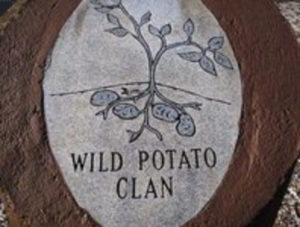 Amadoniyi, (Moytoy II), married Go-sa-du-isga of the Wild Potato Clan (Ani-ga’tage’wi). She was also called Nancy Carpenter, and Nancy Hop (Shawnee) Carpenter. Nancy was born in (1664) in Running Water, Tennessee, Cherokee Nation, Tennessee, and died in August (1732). Her father was Chief Hokolesqua Opeechan Stream “Wynepuechsika Keiga-tugh-qua” Cornstalk, Sachem Cornstalk and he was Nancy Elizabeth (Broom) Ward, Hicks’ great great grandfather. Her mother was a Powhatan woman. We don’t know her name. Nancy Hop (Gosaduisga) Carpenter was Nancy Elizabeth (Broom) Ward Hick’s great grandmother, and the aunt of Swan Wapehti Hop. Swan Wapehti, as well as her birth siblings, could cipher, read and write English. (Shawnee Heritage, page 167). Swan Wapeti Hop was Nancy Elizabeth (Broom) Ward, Hicks’ fraternal grandmother. (Nancy Gosaduisga Carpenter was the sister of Misahpelewa “Big Turkey” Hop, Sachem Cornstalk, who was Swan’s birthfather.)
Amadoniyi, (Moytoy II), married Go-sa-du-isga of the Wild Potato Clan (Ani-ga’tage’wi). She was also called Nancy Carpenter, and Nancy Hop (Shawnee) Carpenter. Nancy was born in (1664) in Running Water, Tennessee, Cherokee Nation, Tennessee, and died in August (1732). Her father was Chief Hokolesqua Opeechan Stream “Wynepuechsika Keiga-tugh-qua” Cornstalk, Sachem Cornstalk and he was Nancy Elizabeth (Broom) Ward, Hicks’ great great grandfather. Her mother was a Powhatan woman. We don’t know her name. Nancy Hop (Gosaduisga) Carpenter was Nancy Elizabeth (Broom) Ward Hick’s great grandmother, and the aunt of Swan Wapehti Hop. Swan Wapehti, as well as her birth siblings, could cipher, read and write English. (Shawnee Heritage, page 167). Swan Wapeti Hop was Nancy Elizabeth (Broom) Ward, Hicks’ fraternal grandmother. (Nancy Gosaduisga Carpenter was the sister of Misahpelewa “Big Turkey” Hop, Sachem Cornstalk, who was Swan’s birthfather.)
The following is a list of the children of Nancy Ani’-Ga’tage’wi Kituah (Go-sa-du-isga) and Moytoy II, Emperor of Telico, Young Tom Carpenter. U-lu-tse; Clo-go-i-tah T Priber of Tellico; Kitegista of Tellico, Cherokee Emissary to England; A-nu-wa-gi (Peggy) Moytoy, Wild Potato Clan; Tathtowe (Tittoe II) of Tellico, Cherokee Emissary to England; Ounaconoa of Tellico, Cherokee Emissary to England; Tame Doe Moytoy; Amouskositte, Amo-sgiasite (“Dreadful Water”) Moytoy, Uku of Great Tellico; Jennie Ani WaYaSkalilosken Moytoy; Ookaii Okuha Moytoy; Kollannah Moytoy; Killaque Conjuror of Tellico; Attakullakulla Moytoy; Wa-Wli (Polly) Sister Of Raven Moytoy and Ah Nee Wa Kee Moytoy.
They also had at least three adopted children. Savannah Tom Carpenter, (Moytoy III) was an Algonquin infant when orphaned and later adopted by Amadoniyi, (Moytoy II) and Nancy (Go-sa-du-isga). They also adopted Swan Wapehti Hop (Chief Broom’s mother) who was also known as Gosaduisga (Nancy Quatsie Five Killer of the Shawnee) and Osashqua Moytoy also known as Taminand Five Killer of the Delaware (Chief Broom’s father). Nancy Ani’-Ga’tage’wi Kituah (Go-sa-du-isga) Corn Stalk Carpenter may have had two other husbands, Francis Ward and Johann Conrad.

Amatoya Moytoy of Chota, (Moytoy I) b.1640 – d.1730, was a prominent town chief in what is present day Tennessee. He held the hereditary title Ama Matai (pronounced mah-tie). The name matai is from French and ama is the Cherokee word for water. It translates as Water Conjurer. He was also known as Trader Tom and Moytoy I. Amatoya Moytoy’s mother and father were Thomas Pasmere Carpenter and Pride of the Shawnee. In 1680, Amatoya married (in 1680), Quatsy of Tellico b. 1650, d. 1692. She was the daughter of Taminad Munsawghe (1607-1675) and Pride Munsawghe (1615-1679). Other names for Quatsy are: Elizabeth, Que-Di-Si, Oo-yo-sti Otiyu, Polly, or Quali of the Ani’-Wa’ya (Ani’-Way’ya = Wolf Clan) and Locha Quatsy Shawnee Qeu disi Carpenter (born Tellico Wolf Clan).
The children Amatoya and Quatsy were: Caulunna, the Raven of Chota, Tistoe l, Nancy Nanye-hi Moytoy, Standing Turkey, Chief of the Cherokee, Ailsey Dougherty, of the Wolf Clan, Aganusitsi Quatie “Quatsy”, Amahetai ll Moytoy of Tellico, Go-la-nv Hop-Moytoy, “Raven of Hiwassee”, Oukah-Ulah Skiagusta, Kanagatoga “Old Hop” Moytoy, First Beloved Man of the Cherokee, and Elizabeth Raven-Hop Moytoy.
Thomas Pasmere Carpenter (1607-1675) was from a family of English Ship owners. He was born in Plymouth England and came to Jamestown, Virginia in 1627. He was living in a cave near the Shawnee tribe when he met and married Pride Chalakahatha Cornstalk, a Shawnee woman. Her mother, Sachem, was of the Turkey clan and her father, Young Cornstalk, was Wind clan. Pride was born around 1615 and died in 1679 in Running Water, Tennessee.
Thomas was called “Cornplanter” by the Shawnee, derived from their sign language that matched as near as possible to the work of a carpenter. The children of Thomas and Pride were Pasmere Carpenter; Mikona “Do Yo Sti” Greenwood, Chalakatha Shawnee; “Rainmaker”, Kishkope Shawnee and Trader Tom, “Water Conjuror” (Moytoy I), who became an important Cherokee town chief. Amatoya, (Moytoy I), was taught by his father, Thomas, to “witch” for water with a willow stick. He had become so adept at water witching that the Cherokee called him “water conjurer” or Ama Matai. He ruled the town of Chota sometime between the beginning of the eighteenth century and 1730.
Many of the descendants of Amatoya Moytoy and Quatsie of Telico went on to become prominent leaders, founding a family that ruled the Cherokee for over a century.
The Carpenter line of ancestors stretches far back in history to England and France and to the first crusades long before Thomas Pasmere Carpenter immigrated to the new world. Their known history begins with Lord Josselin of Melun, Seine-et-Marne, born in 920, who was married to Princess Jeanne de Melan de Bourbon. The British royal family is included as cousins of the Moytoys, through their kinship to Carpenter Earl of Tyrconell. These families will be detailed at the end of the Hicks history.
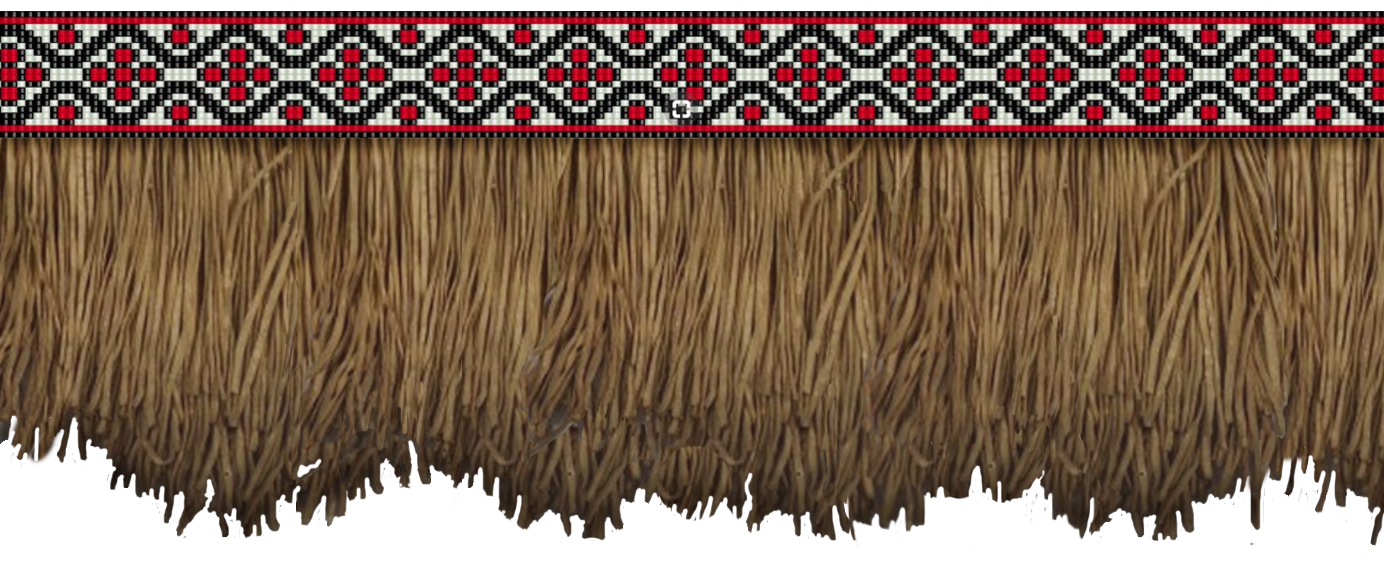
Hicks Family Legacy
Charles Renatus Hicks
The son of Nathaniel Hicks and Nancy Elizabeth (Broom) Hicks, Nanye Hi Ghi Ghau. He was born on January 23, 1767 in Tomothy, Georgia, and died January 20, 1827 Spring Place, Murray County, Georgia. He married Lydia Halfbreed on December 23, 1791. Her Indian named was Chow-U-Ka Gahno. Charles and Lydia had two daughters, Nancy and Catherine. Charles Hicks also had an earlier marriage (1781) to the sister of James Vann and a later marriage to a woman by the name Nancy Broom (Anna Felicitas) b.1770.
This was the Nancy that was baptized on October 19, 1821 by the missionaries at Oochgeelogy, in Spring Place, Georgia. After her baptism, she was called Anna Felicia or Anna Felicitas, being named after the missionary’s wife. It is important to not confuse this Nancy Broom (1770) that Charles married, with Nancy Elizabeth (Broom) Ward, Hicks (b.1736), who was Charles Renatus Hicks’ mother.
Nancy Elizabeth (Broom) Ward, Hicks was the sister of Nancy Atso-s-Ta Broom Full Blood Paint Clan (1720-1741). Atso-sta was the wife of Chief Broom Tauchee “Dutch” and the mother of Nancy Elizabeth (Broom) b.1770, who was called Anna Felicitas. Nancy Atso-s-sta and Tauchee Broom also had a daughter named Corn Tassel, (Diane Bradley), b.1740.
Charles Hicks served as the Principle Chief of the Cherokee Nation in 1827 until his death. He was previously the de facto authority in the Cherokee Nation between 1814 to 1827 because Chief Pathkiller was ill at that time and served as a figurehead only. In 1825 Charles Hicks served as the Treasurer of the Cherokee Nation as well as being second Chief.
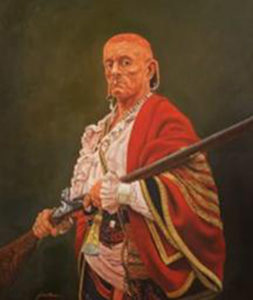 In October 1817, Charles Hicks was described in Starr’s History of the Cherokee Indians:
In October 1817, Charles Hicks was described in Starr’s History of the Cherokee Indians:
“He is a halfbreed Cherokee almost 50 years of age he has very pleasant features and an intelligent countenance. He speaks the English language with utmost facility and with great propriety. I was exceedingly surprised that a Cherokee should be able to obtain so extensive a knowledge of English as he possessed: He reads better than one-half of the white people and writes an easy hand. For thirty years he has been, as occasions required, an interpreter for the United States. As a man of integrity, temperance and intelligence he has long sustained a most reputable character.”
Pathkiller and Hicks both were mentors to John Ross, having identified the talented young mixed-blood Cherokee of Scots-Irish descent as the future leader of the Cherokee people. Charles’ brother William Abraham Hicks was elected Principal Chief after the death of Charles in 1827.
List of Cherokee Nation
Principal Chiefs in Early Times
Moytoy I Chief of Chota 1700-1730
Moytoy II Emperor of the Cherokee 1730-1760
Moytoy III Savannah Tom
Moytoy IV (Chief Broom) Raven of Chota
Kanagatucko Old Hop leading Chief 1760s
Attakullakulla 1760-1775
Oconostota 1775-1780
Hanging Maw 1780-1792
Little Turkey 1792-1801
Black Fox 1801-1811
Pathkiller 1811-1827
Charles Renatus Hicks 1827
William A. Hicks 1827-1828
John Ross 1828-1866
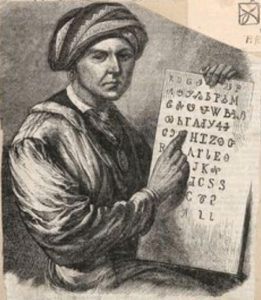 Charles was sent to a private school in Virginia by his Virginia-born father. The first generation of native Cherokee lawyers were the mixed blood children of early whites, who were attorneys in the sense of many gentlemen of the southland. They were essentially planters, farmers, and merchants who had read the law in an office or picked up the knowledge from their own experience, observation and study. Foremost among this group was Charles Hicks who was an important figure in the period of transition from the old ways. He actually wrote the first Cherokee law in Broom Town September 11, 1808.
Charles was sent to a private school in Virginia by his Virginia-born father. The first generation of native Cherokee lawyers were the mixed blood children of early whites, who were attorneys in the sense of many gentlemen of the southland. They were essentially planters, farmers, and merchants who had read the law in an office or picked up the knowledge from their own experience, observation and study. Foremost among this group was Charles Hicks who was an important figure in the period of transition from the old ways. He actually wrote the first Cherokee law in Broom Town September 11, 1808.
It is said that Sequoyah (cousin of Charles Hicks) asked Charles to help him to learn to sign his name on his silversmith work. He learned to sound out the syllables and connect them with the letters that they represented. He was then able (c.1821) to compile the Cherokee alphabet syllabary making reading and writing possible.
Charles Renatus Hicks, son of Nathaniel Hicks and Nancy Elizabeth (Broom) Ward, Hicks, married Lydia (Halfbreed) on December 23rd of 1791, at the town of Tamali.
Lydia Halfbreed (wife of Charles Hicks) was the daughter of James Stand “Big Chief Gu-U-li-Si ‘Will’ Halfbreed” and Qua-la-yu-ga “Old Hannah Halfbreed” Hannah Crittendon. Lydia’s Indian name was Chow-U-Ka Gahno and was of the Wild Potato Clan. She was born in (1774) in Chikamaugua District, Georgia. Lydia and Charles had two daughters. Nancy Hicks was born 1792 and died January 9, 1866. Their second daughter, Catherine (Hicks) Miller was born in 1793 and died in 1839 on the Trail of Tears in Powderly, Kentucky. Lydia was listed on the Siler Rolls (census) in 1851.
Lydia died after 1851 at Fort Gibson, Beaties Prairie, Indian Territory. Lydia Halfbreed was first married to Lenard D. Shaw (date unknown). Then to Chief Charles R. Hicks in 1791. She married William Abraham Hicks, (Charles’ brother) c.1793. They had a son named George Augustus Hicks. Lydia also married Daniel McCoy, James Chisholm, James Foster Jr., and George Chisholm.

Trail of Tears
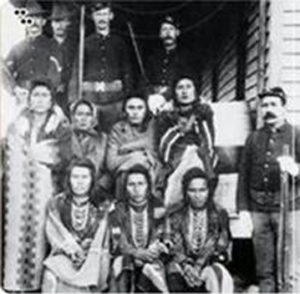 President Andrew Jackson instigated the removal of the Cherokee people by ignoring the Supreme Court mandate barring Georgia from intruding on Cherokee lands. The state of Georgia then began taking Cherokee lands for extremely low compensation and promises of land in the west.
President Andrew Jackson instigated the removal of the Cherokee people by ignoring the Supreme Court mandate barring Georgia from intruding on Cherokee lands. The state of Georgia then began taking Cherokee lands for extremely low compensation and promises of land in the west.
Cherokee property was also taken by greedy settlers. Using the Cherokee’s resistance as an excuse, the Georgia militia moved into Chota and destroyed the printing press used to publish the tribe’s newspaper. A few Cherokees escaped the ensuing round up of Native Americans by taking refuge in the mountains of North Carolina (where some of their descendants still live today). However, most of the members of the Cherokee Nation were forced to leave their homeland.

Lydia Halfbreed came west on the Trail of Tears with many of her family including her mother Hannah Crittendon. Our family had 5 generations on The Trail of Tears at the same time. It is thought that they all traveled in the contingent lead by Catherine’s half brother, George Augustus Hicks, (whose father was William Abraham Hicks). Catherine’s half brother, Elijah Hicks was also a contingent leader of about eight hundred Cherokee people.
The five generations on the trail consisted of Old Hannah Crittendon, her daughter Lydia (Halfbreed) Hicks, Lydia’s daughter Catherine (Hicks) Miller, and Catherine’s son Avery Vann Miller and his children.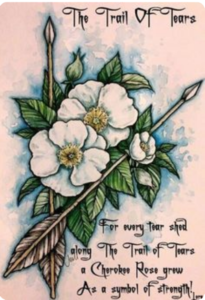 They departed from Mouse Creek Tennessee on November 5, 1838. It is thought that their contingent consisted of about one thousand people. After many grueling months on the trail, the family arrived at Beaties Prairie, (Ft. Gibson) Indian Territory, on March 15, 1839.
They departed from Mouse Creek Tennessee on November 5, 1838. It is thought that their contingent consisted of about one thousand people. After many grueling months on the trail, the family arrived at Beaties Prairie, (Ft. Gibson) Indian Territory, on March 15, 1839.
Two of our family perished on the trail. Catherine died in 1839 in Powderly, Kentucky and the wife of Avery Vann Miller, Nanny Ward, died in 1838 at a place unknown.
Catherine’s grandmother, Old Hannah, survived the Trail of Tears and lived for many years in Indian Territory (present day Oklahoma).
This description was taken from the book, History of the Moravian Missions Among the Southern Indian Tribes by The Rev. Edmund Schwarze, Ph.D. and paints a picture of great, great, great, great Grandmother Hannah Crittendon. Her Indian name was Old Hanna Gua Li Uka. Hannah was born in 1740 and died in 1860 being 120 years old when she passed away. It is said that she was 96 or so years old when she made the trek on the Trail of Tears.
“Accompanied by the Interpreter, Avery Miller, (the [grand]son in law of Hannah Crittendon), Bahnson made many visits in the homes of members in the Canaan neighborhood, noting especially, a call made on “Hannah,” a remarkable Cherokee character. She was probably, the oldest member ever in the Moravian Church, certainly the oldest ever baptized by Moravian missionaries, having been born in 1740, therefore, at this time, 118 years old. Bahnson writes that the house was the smallest he had ever seen, being 10 x 12 feet, with clay floor and a fireplace. Upon a bed lay Hannah, the oldest person Bahnson had ever seen. (“She was all wrinkles.”) She was very weak but able, at times, to go about on a stick. At the age of 108, she had been baptized by our missionaries and had answered the baptismal questions heartily, with childlike faith and eyes full of tears.”
Hannah ‘Gua Li Uka’ Crittendon (my 5th great grandmother) lived to be 120 years old and during that time, experienced monumental change in the lives of the Cherokee people.
The Hicks/Halfbreed family history is recorded on page 448 of the Dr. Emmet Starr’s History of the Cherokee Indians, published by the Warden Company in 1921 in Oklahoma City, Oklahoma.
Catherine (Hicks) Miller, b.1793, d.1839, (Wild Potato Clan), daughter of Charles Hicks and Lydia (Halfbreed) Hicks, married (Old) Andrew Miller (#2) (b.1774, d.1818), and had 7 children. Avery Vann Miller, born in 1815, was the first child.
Avery Vann Miller’s siblings were: Elizabeth b.1817, Alfred b.1819, Elmira b.1821-1884, Isabelle b.1823, Lucinda, 1818-1910, and Andrew Jackson Miller (#3) b.1827-1851. This Andrew Jackson Miller was the uncle of Andrew Jackson Miller (#4).
Old Andrew Miller (#2) was murdered 1818 in Tennessee in the Red Clay area by William Manley over a boundary dispute on Catherine’s Indian land. After Catherine was widowed, she moved to Georgia to be close to her mother, Lydia, and married (around 1804-1814) Thomas Gann and had 4 children. They lived on the Hiawassee River in Georgia before Catherine made the trek on the Trail of Tears.
Old (2) Andrew Miller, Avery Vann Miller’s father, was descended from David Miller and Martha Harris, who was born around 1728 and died 1811. She may have been born around Lancaster, Pennsylvania. Her parents were Charles Harris and Jane McCelhenney. The Charles Harris’ family is recorded in “The Empire Builders: Book 1, The Genealogy of the Harris Family” (Harris family records by Jane Montgomery Seaver, 1929, published by American Historical and Genealogical Society). Included in the direct Harris line, is an array of emperors, kings, queens, and nobility including Robert the Bruce, William the Conqueror, and Charlemagne.
David Miller was born around 1730 and died in March of 1819. He was the son of oldest (#1) Andrew Miller who died in 1776. Old (#2) Andrew’s birth was recorded in April of 1776 in his grandfather’s will in Mecklenburg, North Carolina. (Will book B, pages 52 to 54).
David Miller was a commissioner designated to found the city of Kingston at South West Fort at South West Point in Tennessee. He was Avery Vann Miller’s Grandfather.
Avery Vann Miller, b. December 15th, 1808, d. January 26, 1865, was the son of Catherine (Hicks) Miller and Old (#2) Andrew Miller. Avery’s Indian name was AhWi. He came west on the Trail of Tears with his children and extended family. His wife, Nanny Ward b. 1810, died on the trail in 1839. The children of Avery and Nanny (Ward) Miller were: Joseph Gambold Miller, Sussana Miller, Elmira Miller, David Miller, Martha Jane Miller, and Miller Wart Miller. Avery Vann Miller may have assisted the missionaries while living in Tennessee by translating for them. He may also have interpreted between the Cherokees and the soldiers while on the Trail of Tears.
Avery married Susannah ‘Susie’ Spaniard (census card #1164) about 1840. Susannah was born in 1803 and died on April 25th, 1875. Susie Spaniard’s parents were Frank Spaniard and Hannah Chisholm. Their Indian names were (Ga-lun-ghe) and (N-wa-dee-ya-he). Susie’s Indian name was Wa-tec-nee-ya. She was buried at Hickory Grove Cemetery in 1875 in Indian Territory. It is said that Susie Spaniard donated the land for the cemetery and hers was the first grave there in. Avery and Susannah’s children included: Andrew Jackson Miller (#4), born 21st of July 1845 at Beaties Prairie, Indian Territory. Avery Vann Miller’s sister, Isabelle, married Brig. General Stand Watie, the only Cherokee general in the Civil War.

Civil War Recollections
Andrew Jackson Miller (#4) was born July 21, 1845, at Beaties Prairie, Indian Territory (Cherokee Roll number 23732, index card #2981, line of roll number 2662). Andrew Jackson Miller’s (#4) siblings were: John Morgan Miller, Sarah Ann Miller, Catherine Miller, Elizabeth Miller, and, Thomas Gann Miller.
Andrew Jackson (#4) married Martha Jane Patton in 1873 in Delaware County, Indian Territory. Their marriage ceremony consisted of going to a certain cemetery and riding their horse (or walking) around a tree in the center.
Andrew fought for the South (possibly as a scout along side of Captain Jim Patton, his father-in-law) in the Civil War.
Captain James M. Patten, Martha Jane’s father, enlisted with the Confederates at Frozen Rock, Indian Territory, Muskogee on July 12, 1862 when he was 40. He was in the 3rd Regiment, Company E of General Stand Watie’s 1st Cherokee Mounted Volunteers. Sam Patten and James Patten Jr., Martha Jane’s uncle and brother, enlisted in Company H. Our great grandfather, Andrew Jackson Miller, enlisted at age 18 on December 12, 1862, in Company C. They were all in the 1st Cherokee Mounted Volunteers.
Andrew died July 19, 1906, age 61, in Delaware County, Indian Territory. The only child of Martha Jane (Patton) Miller and Andrew Miller was Susan Victoria (Miller), roll number 22099. She was nicknamed Susahnni by her grandmother, Susie Spaniard.
Martha Jane Patten was born on February 11, 1851, in Jackson County, Arkansas. She had three brothers and three sisters; John. b. 1845, Robert b. 1846, Francis (Sis) b.1848, Mahulda b. 1848, Hindman b. 1859, and Lee, who was named for Gen. Lee, b. 1862. Martha Jane’s mother was named Melissa and her father was James M. Patton who fought in the Battle of Shilo in the Civil War. (The ‘M’ may have stood for Matheson). Her two sisters, Mahulda and Lee died at an early age. Martha Jane was married four times. Her husbands after Andrew were: J.H. Zeleger, Charles Sullivan, and Marshall Reynolds.
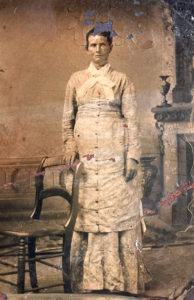 The following is an excerpt from a family history of harrowing stories that Martha Jane Patten (also known as Grandmother Reynolds) told to her granddaughter Pearl (Kearns) McCauley around 1935.
The following is an excerpt from a family history of harrowing stories that Martha Jane Patten (also known as Grandmother Reynolds) told to her granddaughter Pearl (Kearns) McCauley around 1935.
Pictured: Martha Jane (Patten) Miller circa 1868 from a tin type.
“When the Civil War began, the Kansas Jayhawkers robbed them and they moved to Benton county Arkansas where there was a big spring, and three houses. And nearby was a slash with cypress stumps 3 feet high, and buffalo gnats and gal nippers. There is now a summer resort in this place. On a Thursday in the winter of 1863, their home along with the two others, was burned by northern soldiers (The Missouri militia. The so-called Republicans). They came to the house and asked if this was where Captain Patten lived. When they found that it was his house, the leader said “get down, boys, and burn this house”. Jane, then 12 years of age, went into talk to them. It was between breakfast and dinner time. The soldiers picked up the crocs full of milk and drank their fill, and then just dropped the crocs, letting them break. The baby, Kate, was sitting on the bed the soldiers told Jane to take the baby out of the house. She took one quilt wrapped around the baby. The soldiers then set fire to the bed by getting coals from the stove and folding the quilts over them. They stayed until the house burned down. Her mother was one and a half miles up the road, (the Yeargin girl was sick). She started home, saw the fires, met the soldiers and said” you burned my baby”. They said no, the girl took it out.
The family moved into a blacksmith shop and built a fireplace. They had no beds so set up all night. They had nothing but the clothes on their back’s. Five families, from three houses, with nothing to eat.
There was winter snow. They finally got straw in the corners for beds. On Monday, Jane’s mother told her to go back where the house had been to get the pony. Returning with her horse, she met a gang of soldiers riding horseback. They were leading an old poor horse, and offered to trade it for hers. She told them she “wouldn’t be caught dead on that horse.” And besides they stole him. They took her horse but she took off the bridal, and called them all names. One man said “you talk awful sassy to be a little girl”. A gentleman said, you let her alone. Near home she began to cry, her mother ran out to meet her saying, “what is the matter”. She said “those Devils took my horse.”
Another favorite family story concerns Capt. Jim Patten during the Civil War.
“Father bought a bear skin coat in New Orleans. He had several bullet holes in his clothes, but he was never scratched. A bullet struck at the back of the shoulder and cut a trench across the back of the fur coat. He was never wounded although he had seen men fall on each side.”

Established in Indian Territory
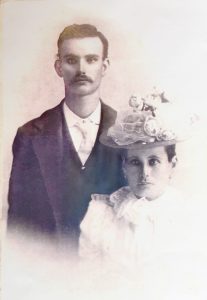 Susan Victoria (Miller) Kearns was born the 15th of May 1874. She had an early marriage to William Calvin “Bill” McCauley. They had one daughter, Bertha. Susan also had an earlier daughter named Eva A. Reynolds, born January 24, 1891 in Indian Territory and died in 1947 in Sacramento California. Eva’s husband had the initials S.B. and was a corporal in the 135th Illinois Infantry in WWI. Susan subsequently married Wesley Eugene Kearns on August 21, 1899 in Independence, Kansas. Susan had black hair and gray eyes. Her wedding picture is included here along with Wesley Eugene Kearns. Wesley and Susan made the train trip to Kansas to be married because it was against Oklahoma law for a white person to marry an Indian. They had nine children including (my mother) Erma Corrine Kearns. The family traveled west to Oregon for work opportunities but returned to Oklahoma c. 1914. Erma Corrine Kearn’s siblings were: Ruth Kearns, Wesley Kearns, Pearl (Kearns) McCauley, Raymond Kearns, Lena (Kearns) Read, Robert Kearns, and half sisters Bertha (McCauley) McCreary and Eva Reynolds.
Susan Victoria (Miller) Kearns was born the 15th of May 1874. She had an early marriage to William Calvin “Bill” McCauley. They had one daughter, Bertha. Susan also had an earlier daughter named Eva A. Reynolds, born January 24, 1891 in Indian Territory and died in 1947 in Sacramento California. Eva’s husband had the initials S.B. and was a corporal in the 135th Illinois Infantry in WWI. Susan subsequently married Wesley Eugene Kearns on August 21, 1899 in Independence, Kansas. Susan had black hair and gray eyes. Her wedding picture is included here along with Wesley Eugene Kearns. Wesley and Susan made the train trip to Kansas to be married because it was against Oklahoma law for a white person to marry an Indian. They had nine children including (my mother) Erma Corrine Kearns. The family traveled west to Oregon for work opportunities but returned to Oklahoma c. 1914. Erma Corrine Kearn’s siblings were: Ruth Kearns, Wesley Kearns, Pearl (Kearns) McCauley, Raymond Kearns, Lena (Kearns) Read, Robert Kearns, and half sisters Bertha (McCauley) McCreary and Eva Reynolds.
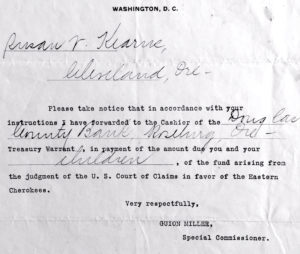 In 1905, the U.S. Court of Claims ruled in favor of the Eastern Cherokee Tribe’s claim against the US government. This resulted in the appropriation of $1 million to the Tribe’s eligible individuals and families. Grandmother Susan Victoria applied to the Guion Miller commission concerning compensation for the land that was left behind in Georgia before the removal of the Cherokee took place. Some years later she received $265.70 as payment for the land. That amount would be worth approximately $6,601 in 2018.
In 1905, the U.S. Court of Claims ruled in favor of the Eastern Cherokee Tribe’s claim against the US government. This resulted in the appropriation of $1 million to the Tribe’s eligible individuals and families. Grandmother Susan Victoria applied to the Guion Miller commission concerning compensation for the land that was left behind in Georgia before the removal of the Cherokee took place. Some years later she received $265.70 as payment for the land. That amount would be worth approximately $6,601 in 2018.
Susan Victoria died in Tulsa, Oklahoma on January 9, 1930. She is interred at Fairlawn, Talala, Oklahoma.
Erma Corrine (Kearns) Baker was born in Oakland, Oregon on March 24, 1913. She had very dark brown hair and beautiful blue eyes. She was the daughter of Susan Victoria Kearns and Wesley Eugene Kearns. Erma and her brothers and sisters grew up on a small farm near Talala, Oklahoma. This was land granted to Susan Victoria Kearns from the Cherokee government. “Indian Land”. Some of Erma’s siblings also received Indian Land, but she was born too late and was not granted any land.
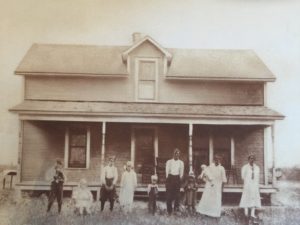 “Our Little House on the Oklahoma Prairie”
“Our Little House on the Oklahoma Prairie”
Above is a picture of the farmhouse at Talala with the whole family.
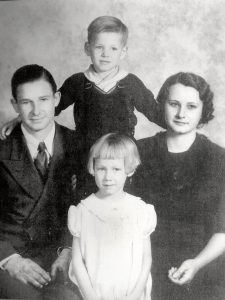 Erma Corrine Kearns married Chandler “Chan” Chesney Baker on February 9, 1930 in Sand Springs, Oklahoma. He was born January 15, 1909, and died March 16, 1960. Chandler was the son of Chesney Chandler Baker and Dorcas Azelia (Brown) from Hamburg Iowa. They had 3 children, Norma Sue (Baker) Macy, b. September 25, 1930, Carl Chandler Baker, b. December 9, 1931, d. March 30, 2015, and Jane Ellen (Baker) Clover, b. February 7, 1945. Erma died September 1, 1985 at Cushing, Oklahoma and was interred at the Fairlawn Cemetery in Cushing. She is warmly remembered as a kind and gentle person who loved growing vegetables and flowers and for being a very good cook.
Erma Corrine Kearns married Chandler “Chan” Chesney Baker on February 9, 1930 in Sand Springs, Oklahoma. He was born January 15, 1909, and died March 16, 1960. Chandler was the son of Chesney Chandler Baker and Dorcas Azelia (Brown) from Hamburg Iowa. They had 3 children, Norma Sue (Baker) Macy, b. September 25, 1930, Carl Chandler Baker, b. December 9, 1931, d. March 30, 2015, and Jane Ellen (Baker) Clover, b. February 7, 1945. Erma died September 1, 1985 at Cushing, Oklahoma and was interred at the Fairlawn Cemetery in Cushing. She is warmly remembered as a kind and gentle person who loved growing vegetables and flowers and for being a very good cook.
Norma Sue (Baker) Macy married Donald Gene Macy on July 18, 1948 in Cushing Oklahoma. They were married for 63 years. During that time, they lived in Oklahoma, Missouri, Louisiana, Texas, New Mexico, Algeria, and Libya. Don worked as a geologist and petroleum engineer and Sue was a stay-at-home mom and later a special education teacher. They had 3 children, David Allen Macy, b. February 28, 1950, Carol Jean (Macy) Clinton, b. January 21, 1951, and Mark Randal Macy, b. February 4, 1958. Don Macy was born February 21, 1928 and passed away October 17, 2009. He was interred at Fairlawn cemetery in Cushing, Oklahoma. Sue Macy resides in Norman Oklahoma and enjoys helping the family with genealogy. She has six grandchildren and two great grand children.

Addendum
An interesting branch of the Moytoy history has to do with our 5th great grandmother Old Hannah Crittendon.
It begins with Cornelius Dougherty (Ahneeunkee) who is said to be the first white man who is known to have resided amongst the Cherokee. He married Ailsey Dougherty, of the Wolf Clan, daughter of Chief Moytoy I and Quatsie. She was our 7th great grandmother. Cornelius and Ailsey had a son named Cornelius Dougherty (#2) who was born about 1700 and died at Seneca Old Town on the Keowee, Cherokee Nation East. He married A-nu-wa-gi (Peggy) Moytoy of the Wild Potato Clan.
She was the Daughter of Amehetai II Moytoy of Tellico and Gosaduisga (Morning Star) of the Wild Potato Clan. A-nu-wa-gi (Peggy) Moytoy was born in 1710 in Gaffney, Cherokee County, South Carolina. She died there about 1742. Cornelius (#2) and Peggy Moytoy had several children including our 6th great grandmother.
Jennie (Dougherty) Crittendon (her Cherokee name has been lost) was born about 1725 and died 1826. Jennie Dougherty married Crittendon (first name unknown). They were the parents of Qua-la-yu-ga “Old Hannah” (Crittendon) Halfbreed Gu-U-li-si. Qua-la-yu-ga Hannah Crittendon, who was born in 1740, married Big Chief Gu-U-Li-Si Will Halfbreed. Their daughter was Lydia Halfbreed, Chow-U-Ka Gahno b.1769. Lydia Married Charles Renatus Hicks about 1790 and they had a daughter, Catherine (Hicks) Miller. She later married Charles Hicks’ brother William Abraham Hicks. Lydia and William had a son, George Agustus Hicks. And so…this strand of the Moytoy family gets woven back in to the mainstream of our Moytoy/Hicks lineage. Hannah Crittenden was also our family’s link to Thomas H. Forrest who helped to found Jamestown in 1608. Thomas’ granddaughter, Anne Forrest, married into the Crittenden family as well. Thomas Forrest brought his wife, Margret Foxe, who is said to be the first English “gentle woman” in the New World. The “Nancys” of the Moytoy family are numerous and sometimes confusing. Here is a summary to aid in keeping them straight.
Nancy Elizabeth Nanye Hi Broom (1736-1822)
She was also known as: Nanye-Hi-Ghi-Ghau Ward; Wildrose; Nannie Ward; Nancy Elizabeth (Broom) Ward, Hicks. Her mother was Nancy Tame Doe Carpenter Moytoy.
Nancy A-tso-s-ta [Paint Clan] (1720-1756)
Wife of Chief Dutch Tauchee Broom and sister of Nancy Elizabeth Nanye-hi Broom. Nancy A-tso-s-ta was mother of Nancy Anna Felicitas (Broom) Hicks who married Charles Renatus Hicks. She was also called Nancy Elizabeth Ann Falicitas Broom, Nancy Felicitas and Atostaha, born around 1770.
Nancy Tame Doe Carpenter Moytoy (1716-1760)
Also known as: Catherine Tame Doe and Tame Doe White Owl Raven Kitigusta. She was the mother of Nancy Elizabeth (Broom) Ward, Hicks and wife of White Owl Raven also known as Anakwanki Skayagustuegwo “Chief Broom”.
Nancy Moytoy of the Wolf Clan (1683-1777)
She was also known as Morning Star, Nanye-Hi Moytoy, Ani’-Ga’tage’wi Kituah Go See Du Issue Raven. She was the wife of Young Trader Tom Moytoy III and was the mother of Nancy Tame Doe Carpenter Moytoy and grandmother to Nancy Elizabeth (Broom) Ward Hicks.
Nancy Carpenter Go-sa du-isga was married to Moytoy II (Emperor of Chota). She was also known as Nancy Carpenter and Nancy Hop Shawnee Carpenter. She was Nancy Elizabeth (Broom) Ward Hicks great grandmother.
Nancy Quatsy Moytoy (Shawnee) (1650-1692)
Also known as Quatsy of Telico. She was the wife of Amatoya Moytoy I and mother of Nancy Gosaduisga Moytoy of the Wolf Clan. Quatsy Moytoy was also called Elizabeth. She was Nancy Elizabeth (Broom) Ward Hicks great great grandmother.

Long Ago Ancestry of the Hicks Family
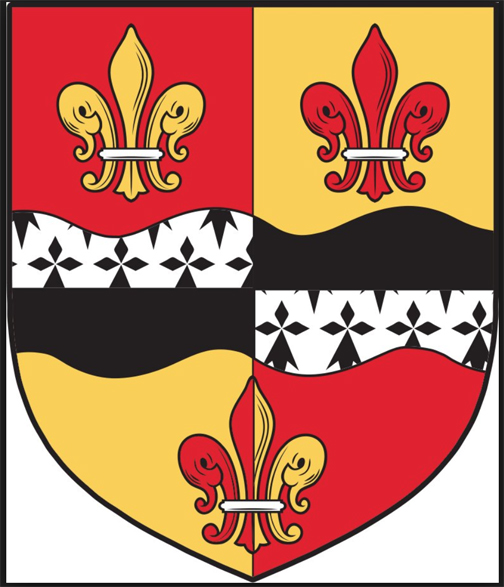
Sir Knight John Hicks, Sr.
Born in 1192, in Bedford England, United Kingdom. He was the son of Lord Robert Hicks and Elizabeth Morgan and father of Sir Knight John Hicks.
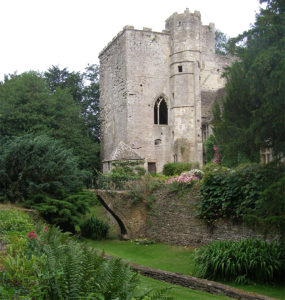 Sir Knight Micheal Hicks
Sir Knight Micheal Hicks
Born about 1282 in Tortworth South Gloucestershire, England. He was the son of Sir Knight Robert Hicks and father of Sir Knight Ellis Hicks.
In the 16th century, Sir Michael Hicks (son of Robert Hicks, a merchant of London and Bristol, and Julia Arthur) owned Beverston Castle (also called Tetbury Castle) and passed the Beverston holding to his son Sir William Hicks, 1st Baronet. The estate remained in the Hicks family through to at least the early 19th century.
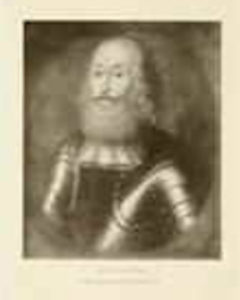 Sir Knight Ellis Hicks
Sir Knight Ellis Hicks
Born 1315 in England.
Died in 1390. He married Elizabeth ( ) Hicks
Children: John Hicks b.1340 in Fortesset, Glouster, England and Thomas Hicks b.1345. Sir Ellis Hicks was Knighted by Edward the Black Prince on the Battle field of Poiters, France September 9, 1356, for bravery in capturing a set of colors from the French.
John Hicks
Born in 1375 in Fortesset, England and died on January 10, 1492 in the same town. Son of Sir Ellis Hicks and Elizabeth Hicks. Husband of Elenor Hicks, Elizabeth Hicks and Margaret Hicks Father of Baptist, Robert, John, Richard, and Thomas of Tortworth, Gloucestershire.
Thomas Hicks of Tortworth
Born c.1487 and died c.1565 Fortesset, Gloucestershire. Married to Margret Hicks and Joan Hicks, son of Sir Knight Ellis Hicks and Elizabeth Father of John Hicks, Sir Baptist, Sir Micheal Hicks and Unknown Hicks.
Born in Fortesset, Gloucestershire, England in about 1551. He died in about 1629 in Surrey, England, and was buried in Chipping Camden. Baptist Hicks married Elizabeth May in 1585. He was knighted on July 23, 1603. Sir Baptist Hicks was the son of Thomas Hicks, of Tortworth, Gloucester and Margret Hicks. He was the textile merchant and imported rich silks from Italy and other foreign places and amassed a large fortune. In 1612 he founded and endowed an almshouse in Chipping Camden as well as building a market hall there in 1627 (both buildings still stand). He performed many other charitable acts, in his life giving $100,000 for charity. He was created a baronet on July 1, 1620.
James Hicks
Born circa 1555 in Southwark, Surrey, England, (London) and died circa 1601 in the same town.
He married Phoebe (Allyn) Hicks.
James was the son of Baptist and Elizabeth (May) Hicks and the father of Baptist, Micheal, John, Ephraim, Mary Henlen, James, Samuel, Robert, Zachariah, Lydia, Daniel, Phoebe and Thomas Hicks.
Sir Robert – Life in England:
Robert Hicks was a fell monger (leather-seller) living on Bermondsey Street in Southwark, London. His first eight children were baptized at St. Mary Magdalen, Bermondsey, Surrey. Thomas Hicks, Sarah Hicks, John Hicks, Robert Hicks, Samuel Hicks, Lydia (Hicks) Bangs, Phoebe (Hicks) Watson, Mary Hicks, Richard Hicks and Ephraim Hicks were the children.
Sir Robert – Life in New England:
Robert Hicks emigrated to Plymouth Colony in 1621 on the Fortune which brought the second party of pilgrims to New Plymouth. His wife and three children came on the Anne in the summer of 1623. He was a freeman in Plymouth by 1636 and served the colony as an arbiter and an appraiser.
John Hicks
Born circa 1605 in Bermondsey, Surry, England. He was the son of Robert and Elizabeth Hicks. He may have immigrated in 1622. John Hicks married Herodias Long. He was the father of John Hicks, born around 1670. His son is sometimes referred to as John Hicks of Virginia. John Hicks died in about 1672.
John Hicks of Virginia
Born in circa 1670-1685 at Charles City, Virginia and died in 1729 in Surry, Virginia. He married Rebecca (Rives) Hicks and was father of Robert Hicks and Abagail Rose. John was the son of John Hicks and Elizabeth (Morgan) Hicks.
Robert Hicks (“Who went to live with the Indians”) was born 1720 in Albermarle, Sussex, Virginia. He died in Sussex, Sussex County, Virginia on January 22, 1780. He was the husband of Mary (Courtney) Hicks b. 1710, d.1752. Robert and Mary Hicks were the parents of Nathaniel Hicks. He had one brother and eight sisters. They were: Steven Hicks, Martha Sarah (Hicks) Bass, Amy Hicks, Elinor (Hicks), Nallapy and (second marriage) Rice, Susanna Hicks, Ann Hicks, Jean Hicks, Jane Hicks, and Tabitha Hicks Robert was the son of John Hicks and Rebecca (Rives) Hicks.

Herve de Melun was born in Ile-de-France, France in 995 and died circa 1084. He married Adelaide de Amiens and was the father of Vicompte de Melun Urison.
Vicompte de Melun Urison was born circa 1018 and died circa 1089. He lived in Ile-de-France and was the father of Vicompte de Melun Guillame Carpentier.
Vicompte de Melun Guillame Carpentier was married to Marie Jeanne Carpentier, D’Armagnac. He fought and was killed in the first Crusades. He was born in 1042 and died about 1099. His son was Sir william Carpentier, De Melun II.
Sir William Carpentier, De Melun II was born in 1058 in Ile-de-France, and died in Ypres, West Vlaanderen, Flanders France in 1125. He was the father Godwin Carpentier.
Godwin Carpentier was born in Melun, Seine-et-Marne, France about 1100 and died in St. Stephen, Bayeux, Normandy, France in about 1194. His son was Raulf le Carpentier.
Raulf Le Carpentier was born in South Yorkshire England in about 1145 and died in Suffolk, England circa 1212. He was the father of Ailric le Carpentier.
Ailric le Carpentier was born in 1166 in Norfolk, England and died in Oxfordshire, England around 1212. He was the father of Elgan Carpentier.
Elgan Carpentier was born in Oxfordshire England circa 1202 and died there in 1267. His father was Siger le Carpentier.
Siger le Carpentier was born in Selles Cambrai, Du Nord, France, Nord-Pas-de-Calais, France. He married Berthe of Holland. They were the parents of Jean le Carpentier. Siger was born 1219 and died in 1267 in Somme, Picardie, France.
Jean le Carpentier was born in 1250 at Du, Nord-Pas-de-Calais, France and he died in 1280 in Tillent, Lambert, Belgium, His son was Maurice Carpentier.
Maurice Carpentier was born in Ypres, West Flanders, Belgium. He died in 1337 in Gloucester England. His son was John Carpenter, MP.
John Carpenter, MP. was married to Jeanne Carpenter who was daughter of de Liskeard. John was born in 1303 in Dilwyne, Herfordshire, England and died there in 1336. He was the father of Richard ‘of London” Carpenter MP.
Richard ‘of London” Carpenter MP was born in 1335 in London, Middlesex, England. His death occurred in Saint Martin’s, Outgate Bishopgate Street, London in 1395. He was the husband of Christina Carpenter and father of John the Elder Carpenter.
John the Elder Carpenter, born in 1372 in London Middlesex, England, was married to Suzanne Katherine Carpenter and was the father of John the Younger Carpenter. John the Elder died on May 12th, 1442 in England.
John the Younger Carpenter was born in 1410 at Homme, Hertfordshire, England. He married Katherine Carpenter and they had a son named William. John died in 1476 at Worcestershire, England.
William Carpenter MP was born in 1440 in Homme, Hertfordshire, England and died there in 1520. William married Agnes Carpenter. They had a son called James “of Dilwyn” Carpenter.
James “of Dilwyn” Carpenter was born circa 1460 in Dilwyn, Hertfordshire, England. He was the husband of Abigail Joan Carpenter and Susan Carpenter. One of their sons was John Carpenter.
John Carpenter MP was born in Barnstaple, Devon, England in 1525 and died there in 1586. He was the husband of Elizabeth Carpenter and father of Thomas Carpenter.
Thomas Carpenter was born on October 29, 1549 in Barnstalple, Devonshire, England and died October 12, 1622 in Broadhembury, Devon, England. He was married to Anne Carpenter. Robert Carpenter was their son.
Robert Carpenter was born in 1578 in Plymouth, Devon England and died there in 1651. Susan Carpenter was his wife and he was the father of Thomas Passmere “Corn Planter” Carpenter. He was Nancy Elizabeth (Broom) Ward Hicks’ 4th great grandfather.
Thomas Passmere “Corn Planter” Carpenter was born on October 29, 1549 in Barnstaple, Devonshire, England.
He married Pride Chalakahatha, of the Powhatan when he came to live near Jamestown in 1627. He died in Running Water Village around 1675.

Acknowledgements
In recording our family linage, many pieces have had to fall into place. Family histories, stories from earlier generations, as well as primary source documentation have been brought together to form this archive. An in-depth list of extended family members, (siblings, aunts, uncles, spouses and great grand parents) has been compiled in hopes that this information may be helpful to others who are searching for clues to their own heritage.
Our sincere thanks go to cousin Rose Guthrie and our Great Aunt Pearl McCauley for providing a wealth of information, genealogy records and family stories, and who are descended, as well, from Avery Miller, Catherine (Hicks) Miller, Charles Renautus Hicks, and Nancy Elizabeth, also known as Nanye Hi Ghi Ghau (Broom) Ward Hicks, Beloved Woman of the Cherokee people.
Posted by:
Norma Sue (Baker) Macy and Jean Macy Clinton
2018

